|
<
>for DAmikeVE...
 |
David G.
Delaney
PhD Candidate
Supervisor: Brian Leung |
Contact
Information:
Department of
Biology
McGill
University
1205 Docteur
Penfield
Montreal, Quebec H3A 1B1
Lab at
McGill: 514-398-1833
Office/Home:
(617) -770-0483
Cell.: (514)
585-8801
DGDelaney {at} gmail {dot}
com | |
|
 |
|
Research
Overview:
My research is
multidisciplinary but mainly falls into the fields
of marine ecology, invasion biology, oceanography,
community ecology, evolutionary biology, and
limnology. Research questions of interest are both
applied and theoretical. I have conducted research
in Canada, U.S., and the Galapagos. I conduct
laboratory and manipulative field experiments
complimented with broad-scale surveys to test
theory and better understand drivers of
large-scale patterns in nature. I endeavour to
identify important biotic and abiotic factors
controlling the diversity of an ecosystem in order
to better inform managers and
policy-makers.
|
 |
<<<
Download
my CV |
| | |
|
Research | Study organisms | Publications & Awards | Media Coverage | Invasive
Tracers Website | Dr.
Brian Leung's
website
|
|
Current
Research:
My current research
is monitoring, managing and modelling the spread of
invasive species. Invasive species are a global,
daunting problem causes over $120 billion dollars of
damage, each year, in the US alone. They are one of the
leading causes for biodiversity loss and the number of
invaders exponentially increases each year. I focus on
marine invasive species, as marine invasion biology lags
behind its counterparts in terrestrial and aquatic
systems. I use the Asian shore crab (Hemigrapsus
sanguineus) and European green crab (Carcinus
maenas) as model organisms. My research has mainly
been conducted from New Jersey to Maine, USA. More
recently, I expanded my research to tunicates by
studying the invasion of the vase tunicate (Ciona
intestinalis), which threatens the multimillion
dollar mussel industry of Prince Edward Island
Canada.
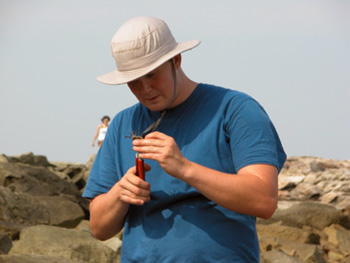 Photo
credit: Linda Hurt Photo
credit: Linda Hurt |
 Photo
credit: Linda Hurt Photo
credit: Linda Hurt |
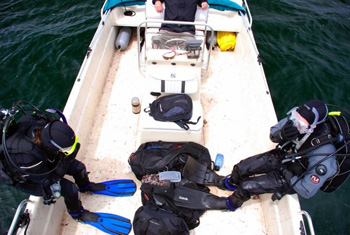 Photo
credit: Michael Becker Photo
credit: Michael Becker |
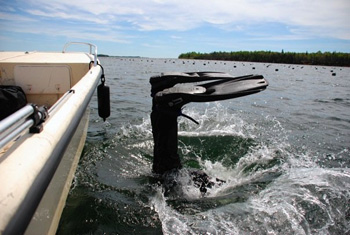 Photo
credit: Michael
Becker Photo
credit: Michael
Becker |
|
Study
organisms:
As widely
distributed organisms, Carcinus maenas
and Hemigrapsus sanguineus were
logical choices for this new type of study and
validation towards yielding the data needed for
the progress of marine invasion ecology.
Carcinus maenas has invaded the coasts of
North America, South Africa, Australia, South
America and other places outside of its native
range of the Atlantic coast of Europe and possibly
northwest Africa. Carcinus maenas was
presumably brought to the Atlantic coast of North
America, in 1817, with solid ballast. By 1989, it
started colonizing the Pacific coast of North
America starting in San Francisco Bay. It was
transported accidentally from the east coast by
activities associated with the live food and bait
trade. Establishment and persistence in these
various environments is likely facilitated by its
omnivorous feeding strategy and its ability
to tolerate a wide range of temperatures and
salinities. A single brood of C. maenas
can contain 185,000 - 250,000 eggs. High
fecundity and the characteristics of a generalist
allow C. maenas to inhabit a diverse
range of marine ecosystems and therefore, reduce
beta-diversity.
|
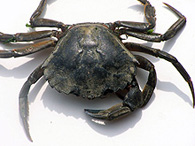 |
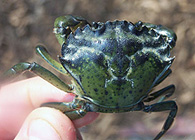 |
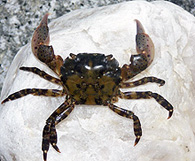 |
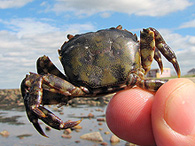 |
|
Carcinus
maenas
European Green
Crab |
Carcinus
maenas
5 teethed green
crab |
Hemigrapsus
sanguineus
Asian Shore
Crab |
Hemigrapsus
sanguineus
Photo credit: Flickr
Dr.
Jennifer Forman Orth
|
Similarly,
H. sanguineus is a generalist, an
omnivore, and a highly invasive brachyuran crab.
Hemigrapsus sanguineus is native to the
western Pacific but has colonized multiple
locations in Europe and during 1988 it was first
detected on the eastern coast of North America, in
New Jersey. Traffic of foreign cargo vessels was
presumably the vector that brought the Asian shore
crab to North America. In its native range, H.
sanguineus inhabits waters that range from
above 30 to below 5oC. With a high fecundity in
the form of multiple broods of up to 60,000 eggs
each breeding season, H. sanguineus has
expanded its invasive range along the eastern
coast of the United States, and has colonized from
Oregon Inlet, North Carolina to Schoodic
Peninsula, Maine.
|
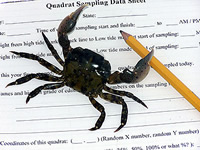 |
Publications:
Delaney, D.G.,
Sperling, C.D., Adams, C. and Leung, B.
2008. Marine invasive species: validation of
citizen science and implications for national
monitoring networks. Biological
Invasions 10:117-128.
Delaney, D.G.
2008. Verifying the validity of volunteer
monitoring to increase its utility: An academic
perspective. U.S. Environmental Protection
Agency's The Volunteer Monitor Newsletter
19:1.
Griffen, B.D. and Delaney, D.G. 2007.
Species invasion shifts the importance of predator
dependence. Ecology
88:3012-3021
Delaney, D. G. 2007. In the
Spotlight: The Marine Invasive Species Monitoring
Organization. The National Institute of Invasive
Species Science Citizen Science Newsletter
1:2. |
|
Leung,
B. and Delaney, D.G. 2006. Managing sparse
data in biological invasions: a simulation study.
Ecological modeling
198:229-239.
Delaney, D.G.
and Solecki, A. 2005. Citizen science as a
solution to invasive species. Gulf Stream
Newsletter: A publication of the Gulf of Maine
Marine Educators' Association 3:4.
|
Awards
- 2009 Alma Mater
Student Travel Grant Award ($750)
- 2009 Graduate
Training Committee Travel Award ($250)
- 2008 Gulf
of Maine Visionary Award for innovating thinking and
commitment to protecting the Gulf of Maine environment
and surrounding waters
- 2007 University of
Maine's Addison E. Verrill Award for Marine Biology
($2,000)
- 2006 McGill
Graduate Studies Fellowship Award ($5,000)
- 2006 NSF Honorable
Mention Graduate Fellowship Award
- 2005 Co-PI on a
grant from NOAA's National Sea Grant ($134,473)
- 2005 E.C. Pielou
Award for best oral presentation on statistics by a
graduate student at the 90th Ecological Society of
America's annual meeting ($200)
- 2005 McGill
Graduate Studies Fellowship Award ($5,000)
- 2003 New England
Aquarium's Award for Excellence and Leadership
- 2002 New England
Aquarium's Rookie of the Year Achievement Award
- 1998 Award for
Distinction from Boston University Academy for
obtaining a GPA greater than 3.5 in Boston University
classes while I was still in high school
- Community Service
Award of 1996, 1997, and 1998 from Boston University
Academy
Media coverage
|
|
|
| |
Last update:
Feb. 18,
2009 | |
|








